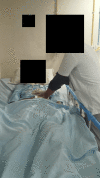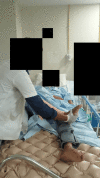Importance of Cardiac Rehabilitation and Mouth Opening Exercises in Oral Squamous Cell Carcinoma: A Case Report
- PMID: 38249192
- PMCID: PMC10800147
- DOI: 10.7759/cureus.50954
Importance of Cardiac Rehabilitation and Mouth Opening Exercises in Oral Squamous Cell Carcinoma: A Case Report
Abstract
The most prevalent malignant tumor in the oral cavity is squamous cell carcinoma (SCC). Social interactions are impeded, including eating, conversing, and practicing basic oral hygiene. A 43-year-old man who had previously suffered pus discharge in the right side of the buccal mucosa complained of dull aching in the lower right back of his jaw. The patient's right buccal mucosa was surgically treated for SCC two years ago. He received 30 cycles of high-dose radiation therapy for SCC of the right buccal mucosa. The right maxilla and mandible had osteoradionecrosis, according to a clinical and radiographic assessment. The aim of emphasizing the importance of cardiac rehabilitation and mouth opening exercises in oral squamous cell carcinoma (OSCC) is to address the multifaceted impact of this type of cancer on a patient's overall health and well-being. OSCC refers to a type of cancer that occurs in the cells lining the oral cavity, including the lips, tongue, gums, and the floor of the mouth. The implications of OSCC go beyond the local effects on the oral region and can have systemic consequences, affecting various aspects of a patient's health.
Keywords: anterolateral thigh flap; cardiac rehabilitation; oral squamous cell carcinoma; pain; physical therapy.
Copyright © 2023, Bhoyar et al.
Conflict of interest statement
The authors have declared that no competing interests exist.
Figures
Similar articles
-
Positive Outcomes of Physiotherapy in a Post-operative Case of Squamous Cell Carcinoma of Tongue and Buccal Mucosa Along With Transfemoral Amputation.Cureus. 2023 Dec 13;15(12):e50435. doi: 10.7759/cureus.50435. eCollection 2023 Dec. Cureus. 2023. PMID: 38222148 Free PMC article.
-
Oral Squamous Cell Carcinoma of the Right Buccal Mucosa: A Case Report.Cureus. 2024 May 3;16(5):e59571. doi: 10.7759/cureus.59571. eCollection 2024 May. Cureus. 2024. PMID: 38826907 Free PMC article.
-
Physiotherapy for Trismus Using Rocabado Exercises Following Mandibulectomy for Squamous Cell Carcinoma of the Lower Lip: A Case Report.Cureus. 2022 Nov 9;14(11):e31293. doi: 10.7759/cureus.31293. eCollection 2022 Nov. Cureus. 2022. PMID: 36514584 Free PMC article.
-
Contemporary Diagnostic Imaging of Oral Squamous Cell Carcinoma - A Review of Literature.Pol J Radiol. 2017 Apr 7;82:193-202. doi: 10.12659/PJR.900892. eCollection 2017. Pol J Radiol. 2017. PMID: 28439324 Free PMC article. Review.
-
Clinicopathological correlation of tumor-stroma ratio and inflammatory cell infiltrate with tumor grade and lymph node metastasis in squamous cell carcinoma of buccal mucosa and tongue in 41 cases with review of literature.J Cancer Res Ther. 2020 Apr-Jun;16(3):445-451. doi: 10.4103/0973-1482.193113. J Cancer Res Ther. 2020. PMID: 32719249 Review.
Cited by
-
Original Personalized Reconstruction Method for Certain Large Tumors of the Lower Lip (Not Including Oral Commissures).Medicina (Kaunas). 2024 Dec 24;61(1):4. doi: 10.3390/medicina61010004. Medicina (Kaunas). 2024. PMID: 39858986 Free PMC article.
-
Integral Role of Chest Physiotherapy and Proprioceptive Neuromuscular Facilitation in Improving the Oxygenation Index and Quality of Life of Patients With Squamous Cell Carcinoma: A Case Report.Cureus. 2025 Jan 26;17(1):e78009. doi: 10.7759/cureus.78009. eCollection 2025 Jan. Cureus. 2025. PMID: 40007924 Free PMC article.
References
-
- Management and prognosis of physical therapy for the post-surgical sequelae of metastatic cervical lymphadenopathy. Saifee SS, Patil S, Thorat RB, Lalwani SS, Lakkadsha TM. https://assets.cureus.com/uploads/case_report/pdf/106944/20220903-30565-... Cureus. 2020;14:1–5. - PMC - PubMed
-
- Should PET/CT be implemented in the routine imaging work-up of locally advanced head and neck squamous cell carcinoma? A prospective analysis. Cacicedo J, Fernandez I, Del Hoyo O, et al. Eur J Nucl Med Mol Imaging. 2015;42:1378–1389. - PubMed
-
- Osteoradionecrosis of the posterior maxilla: a new approach combining erbium: yttrium aluminium garnet laser and Bichat bulla flap. Porcaro G, Amosso E, Mirabelli L, Busa A, Carini F, Maddalone M. J Craniofac Surg. 2015;26:0–9. - PubMed
Publication types
LinkOut - more resources
Full Text Sources
Research Materials



